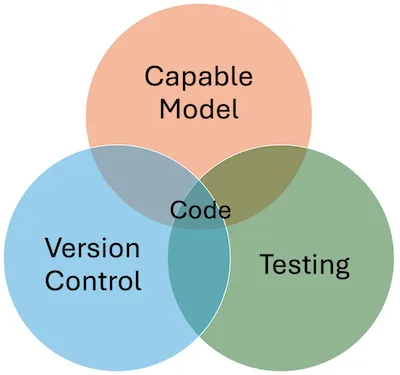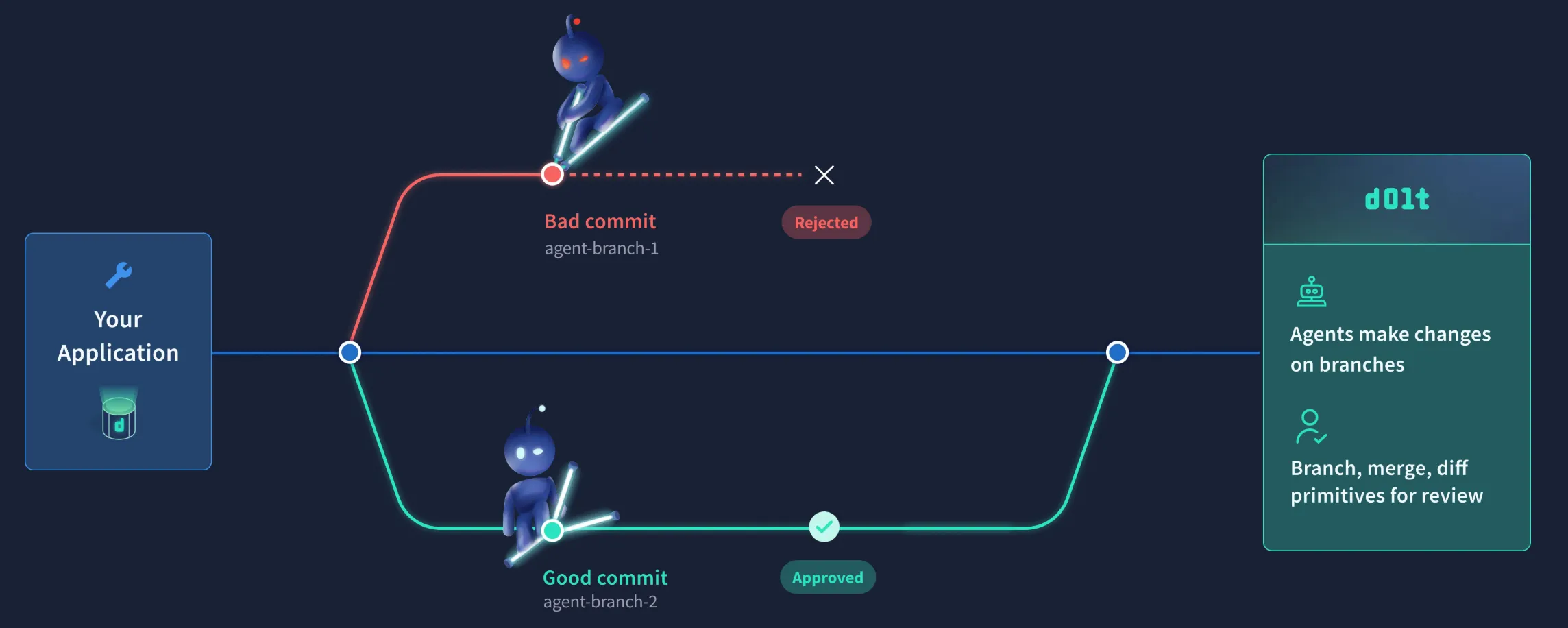To me, the dawn of agentic AI was the release of Claude Code on February 24, 2025. It’s hard to believe that agentic AI is only six months old. Claude Code became my best friend, only to be usurped by Cursor Agent using my best coding agent bake-off methodology. A lot can happen in six months.
Here at DoltHub, we’re especially interested in agentic workflows. After studying how coding agents work, we think Dolt is the perfect database for agents. Agents need three pillars to operate correctly: a capable model, version control, and testing. Dolt provides version control and testing on databases instead of files, extending agentic workflows beyond code to any application. This article explains.
How Coding Agents Work
Coding agents rely on a capable AI model looping until a verifiable goal set by the user prompt is achieved. The goal is verified with a combination of code compilation and tests passing. The more layers of testing your code has, the better agents perform, working for longer without user intervention and producing better results. If you watch the output from your favorite agent, you’ll see this process happening in real time.

The coding agent is operating in a version controlled environment, the best being Git. Agents make mistakes and you want to be able to easily roll back any changes an agent makes. You also want to review those changes by inspecting them, or viewing “diffs” in version control parlance, which ensures code quality and correctness. It’s best to have the agent operate on a separate copy of the code called a clone in Git parlance. This allows you and an agent to work independently without stepping on each other’s toes. Without version control, you would be relying on perfect prompts and perfectly correct edits, which seem impossible for current and maybe even future models. Version control is an essential part of the agentic coding workflow.
Put more simply, coding agents need three things: a capable model, version control, and testing. These are the three pillars of agentic artificial intelligence.

Capable Model
Generative artificial intelligence models are where all the hype is. Are you using Claude Sonnet 4.1, GPT-5, or Gemini 2.5 Pro? New AI models are released to the same fanfare as new smartphones ten years ago. Model performance on many tasks is improving rapidly, including the ability to analyze and produce code.
However, I don’t think the model matters as much as many people think it does for coding agents. When tested, Cursor was able to perform well in the free tier using no state-of-the-art model. Moreover, I notice little difference between state-of-the-art models for my coding tasks. I could not detect much difference between GPT-5 and Claude Sonnet, except for the price.
Version Control
Agents need branches. It’s not just us who think so. Cursor, a leader in the agentic coding space, said so on Lex Friedman.
You need agents operating on a system that is version controlled. Agents often make mistakes. You need the ability to discard changes or quickly roll back. A human and/or another agent must review what changed using a diff interface. Moreover, you want the ability for dozens or even hundreds of agents to operate in parallel. Branches and clones allow for extreme parallelism of changes while managing merges and conflicting writes.
Testing
Agents need tests. It’s in the Claude Code documentation.
Agents can operate for longer and produce more correct results without human input if there is a verifiable output. Code must compile. If the code has a unit or integration test suite. Those test suites must pass. The agent will loop, modifying code, until the output is verified. Test driven development, a coding approach where tests are written first, is the way to get the best results from coding agents.
If you have a coding agent work on a codebase with and without tests, you will quickly see the importance of tests. Testing at least doubles the productivity and correctness of an agent.
For agentic coding, automated verification of output using tests is the least talked about reason why coding agents work. All the credit is given to the models when good testing seems to provide even more leverage to an agent.
Agents for Everything that Isn’t Code
If you believe that capable models, version control, and testing are the three pillars of agentic coding, how can we bring version control and testing to more domains, increasing the scope and scale with which we can deploy agentic workflows? We think we built the answer. The persistence layer of most software is a database. Dolt brings version control and testing to the database. Use whatever model fits your needs. Dolt enables agentic workflows for everything that isn’t code.

Dolt implements full Git-style version control on a MySQL or Postgres compatible database. All the commands you know and love from Git work the same way in Dolt except the target is database tables, not files. In SQL, version control operations are exposed as procedures, functions, or system tables. Dolt is the first and only version controlled SQL database.
Dolt has a rapidly improving built-in test suite. Relational databases already have powerful schema constraints that ensure data quality and prevent agent mistakes. Dolt goes beyond traditional database schema and implements two layers of testing. Dolt unit tests allow for simple, local, read-only assertions on your database. Dolt CI allows for more powerful, complex workflows that are intended to be run on DoltHub or DoltLab, similar to GitHub Actions driven testing on GitHub.
Practically, to enable agentic workflows on your service, migrate the backend for your API to Dolt. When an agent connects to your API to perform a task, have it connect on a branch or clone. The writes the agent makes are safely isolated to that branch or clone. When the agent is done, compare the branch or clone to your production database. Use human-driven or automated workflows to review the data and/or schema changes using Dolt’s fast, queryable diff functionality. If the changes are good, execute a merge. If the changes are bad, iterate or throw the branch away. Add Dolt tests to allow the agent to work longer and more correctly on your database. The agentic model that works so well for code can work for your application with Dolt.
Conclusion
The three pillars of agentic workflows are a capable model, version control, and testing. Dolt provides version control and testing to databases, the backing store of most software applications. Dolt makes agents viable for everything that isn’t code. Interested in implementing an agentic workflow using Dolt? We’re always on our Discord ready to discuss.

